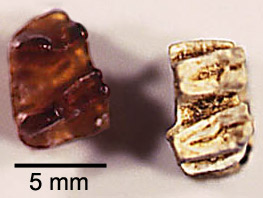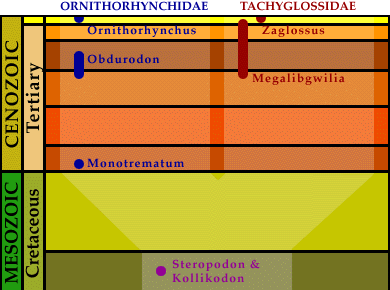



Monotremata: Fossil Record
The oldest fossil monotremes come from the Lightning Ridge opal fields of New South Wales, Australia. An opalized lower jaw fragment of Steropodon galmani more than 100 million years old (middle Albian, Cretaceous) was found containing three distinctive teeth remarkably similar to those of the juvenile platypus. From the size of the jaw, it is estimated that the living animal was about the size of a cat, making it one of the largest Mesozoic
 |
During the 1970s, the first Tertiary monotreme fossils were uncovered in southern Australia. Over several years, a jaw, a pelvis, and teeth of the Miocene platypus Obdurodon insignis were discovered. Cast of Obdurodon teeth are pictured at left. More recently, a skull with a nearly full complement of teeth has been found in New South Wales (Archer et al. 1992). This new species, O. dicksoni, demonstrates that unlike the modern platypus, Obdurodon kept its teeth at maturity. Like the platypus, however, Obdurodon had an elongated snout, though straighter than in its modern relative. Opinions differ on whether Obdurodon may have been aquatic, based on its association with numerous terrestrial marsupials.
 Stratigraphy of monotreme fossils: The chart above shows the stratigraphic ranges over which monotreme fossils have been found. Fossil ornithorynchids (platypus) are shown in blue, while tachyglossids (echidnas) are shown in red. No other systematic relationships are implied by the diagram. |
The Australian fossil record of monotremes also includes some quite good Miocene and Pleistocene fossils of giant echidnas. Three species are known, two assigned to the genus Megalibgwilia (Griffiths et al. 1991). Several nearly complete skulls of M. ramsayi have been recovered from caves in South Australia. The largest of the giant echidnas, Zaglossus hacketti, is known only from a few bones found in Western Australia; it ranks as the largest monotreme ever to have lived.
The time and place of monotreme origin is still largely unkown. Most fossil monotremes have been found in Australia, though a Paleocene platypus tooth (Monotrematum) has recently been recovered from Argentina (Pascual et al. 1992), suggesting they were once distributed across southern Gondwana.
Sources:
- Archer, M., T.M. Flannery, A. Ritchie, and R.E. Molnar. 1985. First Mesozoic mammal from Australia — an early Cretaceous monotreme. Nature 318:363–366.
- Archer, M., F.A. Jenkins, Jr., S.J. Hand, P. Murray, and H. Godthelp. 1992. Description of the skull and non-vestigial dentition of a Miocene platypus (Obdurodon dicksoni n. sp.) from Riversleigh, Australia, and the problem of monotreme origins. Pp. 15–27 in M.L. Augee (ed.). Platypus and Echidnas. Royal Zoological Society of New South Wales.
- Flannery, T.F., M. Archer, T.H. Rich, and R. Jones. 1995. A new family of monotremes from the Cretaceous of Australia. Nature 377:418–420.
- Griffiths, M., R.T. Wells, and D.J. Barrie. 1991. Observations on the skulls of fossil and extant echidnas (Monotremata: Tachyglossidae). Australian Mammalogy 14:87–101.
- Pascual, R., M. Archer, E.O. Juareguizar, J.L. Prado, H. Godthelp, and S.J. Hand. 1992. First discovery of monotremes in South America. Nature 356:704–706.
- Quirk, S., and M. Archer (eds.) 1983. Prehistoric Animals of Australia. Australian Museum, 80 pp.
